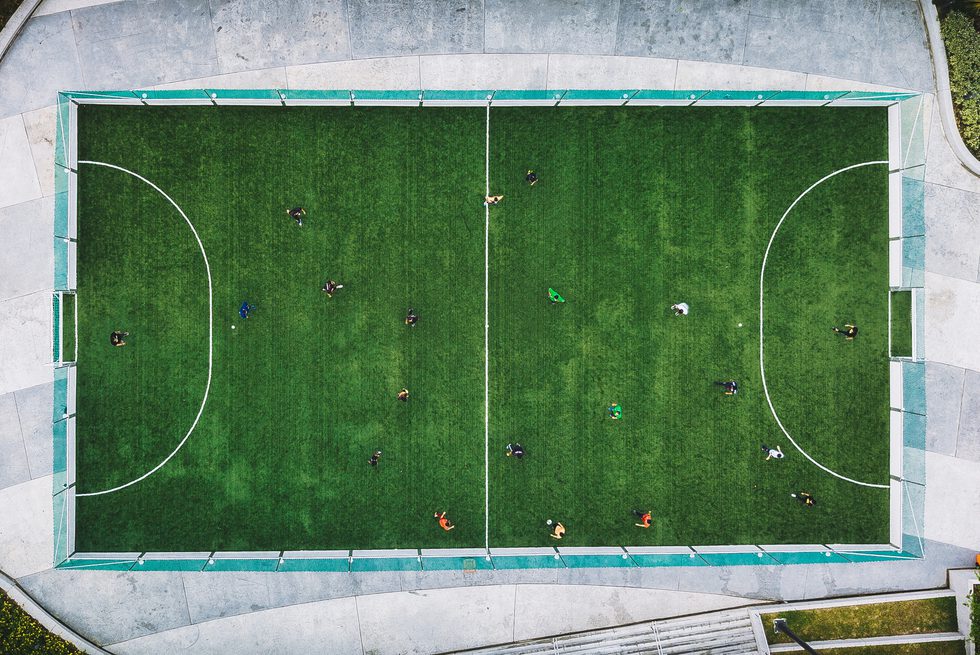Sports: Provocation
From the Series: Sport
From the Series: Sport


October 30, 2012, The Hague: Ladies-Only training session
Fouzia (the trainer) told us that we were not training hard enough, because she never saw anyone vomit in Ladies-Only kickboxing training. Naima, with whom I was training, responded: “But we’re girls, right? We don’t have to do exactly the same as they do in the men’s training?” Fouzia answered elaborately by sharing a personal experience. One day, she was training with a new male pupil, who told her she could punch and kick as hard as she wanted because she was a girl. So, she did and she said she “totally destroyed him.” Naima just nodded and we continued the exercise. Then she whispered: “Well I don’t want to vomit. Do you?” I shook my head and we continued taking it easy.
Ladies-Only training contests the masculine practice of Thai-/kickboxing by challenging the aggressive, competitive, and painful nature of the sport. The participation of girls and women in the sport is often motivated as a form of ‘empowerment’ by both the gyms and local governments, incited by national policies. The wider public tends to hold negative views of kickboxing as an excessively aggressive sport. Yet in the case of women, kickboxing is perceived as emancipatory enskillment and a form of self-defense. My research on female kickboxing practices in the Netherlands explores how ideas of masculinity and femininity are contested and reproduced in sports.
The gender-segregated training sessions I participated in were very popular amongst young Muslim girls, mainly of Moroccan descent. Ladies-Only classes improve the access to sports for many young girls. Not only because it enables them to engage in sports without any men present, but also because it allows them to practice kickboxing at their leisure in their own neighborhoods. The Ladies-Only training sessions differ in various ways from the mixed-gender sessions, where most participants are men. The set-up of a gender-segregated space, the modified teaching techniques, but also the ambitions and opinions of the young women themselves give the training sessions are particular configuration.
While the main focus of kickboxing is competition, Ladies-Only training is on the one hand more often used to achieve a certain body ideal and socialize with friends. This is partly due to the training styles of the teachers, who intentionally lower the intensity and difficulty of training to make it accessible to a wider range of students. On the other hand, participants in Ladies-Only training make a deliberate effort to feminize their kickboxing practice, as the excerpt from my field notes quoted above shows. These decisions shape kickboxing practice in a way that accommodates to their expectations, ambitions, and beliefs. Being a kickboxer helps them achieve a strong, self-confident, and health-conscious notion of self.
Yet their ambitions were also influenced by mainstream ideas about what the feminine body should look like. During fieldwork, I realized the skills taught were identical in the men's and the women's training sessions. Jabs, uppercuts, high kicks and low kicks, as well as abdominal exercises, push-ups and cardio exercise, were basically the same in both types of training. But because the objectives of many women in Ladies-Only kickboxing are different, the development of the skills is verbalized differently. This difference affects not only how the men and women learn these moves but also how they learn to use their bodies and ultimately how they learn to value what they can and cannot, or should and should not do to and with their bodies.
In mixed-gender training, where competition is the most important incentive for the participants, the discourse is focused on fighting. When the trainer explains a certain move, the imagined opponent in the fight is often mentioned in order to demonstrate its effectiveness in a fight. For example, an uppercut should be at a certain height to hit the opponent’s chin, or abdominal exercises are important for being able to catch the opponent’s punches. In Ladies-Only training, the instructions are less about fighting and more about fitness and form. When doing abdominal exercises, instructions are focused on losing weight and tightening the body. Squats are designed to tighten the buttocks, but not to strengthen the legs to be able to catch kicks, as the trainers would explain it to male pupils. In short, while the discourse in the men’s class is about learning to do things with one’s body, the discourse in the Ladies-Only class focuses on doing things to one’s body. Both are forms of body modification: the former creates the “active and useful” masculine body, the latter the “aesthetically pleasing” feminine body.
Most people would expect young female fighters to learn how to empower, emancipate and defend themselves. Ladies-Only kickboxing however, also gives them the possibility to connect with a mainstream discourse of body modification and beauty practices. This raised a dilemma for me. It was exciting to see young women taking up sports to shape their lives in the way they chose. But the decision not to strive for competition, the desire for a slim and shapely body, and the obsession with the color pink made me think about my own reasons for and experiences as a woman learning how to kickbox. How are ideas of what is healthy, beautiful, and feminine influenced by extant structures? And how does the potentially empowering and emancipating ideal of young Muslim women participating in kickboxing, and sports in general, square with the heteronormative foundation of their actual involvement in sports?